Keeping your child safe while traveling in a vehicle is a top priority for any parent. Understanding and adhering to Maine's car seat laws is crucial for ensuring your child's well-being. This comprehensive guide will break down Maine's car seat regulations, addressing common questions and concerns.
What are Maine's Car Seat Laws?
Maine law requires children to be properly restrained in a car seat or booster seat until they reach the age of 8 years old or are 4'9" tall, whichever comes later. This is a key aspect of Maine's child passenger safety regulations. Failing to comply can result in fines.
Here's a more detailed breakdown based on age and height:
-
Rear-Facing Car Seats: Infants and toddlers should ride in a rear-facing car seat until they reach the highest weight or height allowed by the manufacturer of the car seat. This is generally recommended until at least age 2. Rear-facing is the safest position for young children.
-
Forward-Facing Car Seats: Once a child outgrows their rear-facing car seat, they should transition to a forward-facing car seat with a harness. They should remain in this type of seat until they reach the maximum weight or height limit specified by the manufacturer.
-
Booster Seats: After outgrowing their forward-facing car seat, children must use a booster seat until they meet the height and weight requirements to safely use an adult seat belt (4'9" tall and 8 years old). Booster seats raise the child so the adult seat belt fits correctly across their chest and hips, preventing serious injury in a crash.
-
Adult Seat Belts: Once a child reaches the height and age requirements (4'9" and 8 years old), they can use an adult seat belt. However, it's crucial to ensure the seat belt fits properly.
What if my child is over 8 but under 4'9"?
Maine law requires children to remain in a booster seat until they are both 8 years old and 4'9" tall. If your child turns 8 but is shorter than 4'9", they must continue using a booster seat until they reach the height requirement.
Where should car seats be placed in the vehicle?
The safest place for a car seat is in the back seat, away from airbags that could cause injury in a crash. This applies to all types of car seats – rear-facing, forward-facing, and booster seats.
Are there specific requirements for the type of car seat?
Maine law doesn't specify particular car seat brands or models. However, it's crucial to choose a car seat that meets current federal safety standards. Look for the sticker indicating compliance with these standards. Always follow the manufacturer's instructions for proper installation and use.
What are the penalties for violating Maine's car seat laws?
Violation of Maine's car seat laws can result in fines. The exact amount of the fine can vary depending on the specifics of the violation.
How can I learn more about proper car seat installation?
For further assistance with proper car seat installation and selection, consult certified Child Passenger Safety Technicians (CPSTs). Many local hospitals, fire departments, and police departments offer car seat safety checks. You can also find resources online from organizations like Safe Kids Worldwide.
This information is for general guidance only and should not substitute advice from a certified child passenger safety technician. Always refer to the specific instructions provided with your child's car seat and consult with a professional if you have any questions or concerns. Your child's safety is paramount.
